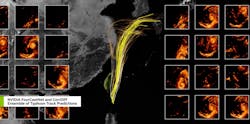How Earth-2 Uses AI to Make Quick Weather Forecasts
What you’ll learn:
- How Earth-2 uses AI and GPU hardware to make forecasts.
- Weather-pattern simulations created with Nvidia’s Omniverse.
- How GraphCast predicts weather a week-plus in advance.
NVIDIA developed an AI climate-prediction cloud platform called Earth-2 that’s designed to run AI models for high-resolution climate and weather simulations. Earth-2 employs the company’s new CorrDiff AI generative model and its FourCastNet machine-learning model. The platform is also incorporated with Omniverse, improving climate and weather simulation capabilities.
For more efficient and precise weather forecasts, Earth-2 uses an advanced AI model called GraphCast. Earth-2 runs on NVIDIA DGX GH200, HGX H100, and OVX supercomputers, enabling high-speed climate simulations at scale.
In addition, the platform leverages CUDA-X microservices software, providing cloud APIs hosted on the DGX cloud for users to generate AI-powered emulations for climate and weather simulations. High-res weather event simulations include local cloud cover, typhoons, turbulence, global atmospheric conditions, and other severe weather phenomena. If needed, the APIs can also be used to create warnings and forecasts much faster than standard CPU-based models.
Predicting Weather with FourCastNet
FourCastNet is a data-driven weather predictor of unusually high resolution, operating at 0.25 degrees (25 km) and covering 1,000,000 pixels globally. It also uses GPU acceleration for performance and efficiency enhancements. This AI is optimized to scale on supercomputers, such as Perlmutter, JUWELS Booster, and Selene, which use 3,808 NVIDIA A100 GPUs.
Short- to medium-range high-res weather forecasts are provided through its advanced machine-learning model. Its transformer architecture with Adaptive Fourier Neural Operator (AFNO) Blocks trained the model on 10 TB of historical weather data. This data is sourced from a subset of the European Center for Medium-Range Weather Forecasts (ECMWF) ERA5 reanalysis dataset, which includes hourly estimates of different atmospheric parameters.
By using the ERA5 dataset’s weather conditions, the AFNO can predict how they change. This allows it to learn weather patterns for precise future weather predictions. In less than two seconds, the model can make a one-week weather forecast—much faster than standard numerical weather prediction models, such as ECMWF’s Integrated Forecasting System (IFS). Plus, it’s more accurate than IFS for large-scale parameters, outperforming it in terms of complex fine-scale structures like precipitation.
FourCastNet predicts 20 atmospheric variables. These include integrated total column water vapor and surface-level data (U10 zonal wind, V10 meridional wind, 2-meter temperature, surface pressure, and mean sea level pressure.) The model measures different parameters at certain atmospheric pressure levels. At 1000 hPa, the mode focuses on U (zonal winds), V (meridional wind), and Z (geopotential height). At 850 hPa, it measures T (temperature), U, V, Z, and RH (relative humidity). When reaching 500 hPa, it records T, U, V, Z, and RH. But at 50 hPa, it only measures Z.
NVIDIA’s Super-Resolution GenAI Model
CorDiff is NVIDIA’s generative AI model that improves weather predictions at super-resolution via downscaling, improving the forecasts’ precision and detail (Fig. 1). The model produces images 12.5X higher than numerical models and gets its efficiency by running 1,000X faster than physical simulations. More impressively, it has 3,000X greater energy efficiency compared to physical simulations.
The AI model’s regression and diffusion networks use a UNet architecture (similar to Elucidated Diffusion Models) containing six encoder layers and six decoder layers. It also has approximately 80 million parameters. This provides the model with weather forecast downscaling and super-resolution capabilities.
High-res radar-assimilated Weather Research and Forecasting (WRF) data and ERA5 reanalysis data trained the CorrDiff AI model via a dataset at one-hour time resolution. 25-km resolution forecasts are fed into the model, generating 2-km high-resolution outputs in response. With this enhanced detail, more accurate weather forecasts can be made, especially for fine-scale weather phenomena.
With its advanced diffusion modeling methods, CorrDiff fixes low-resolution forecast errors and synthesizes essential metrics for decision-making. Although CorrDiff was optimized to predict the weather in Taiwan, there were plans to expand its availability to other global areas as part of NVIDIA’s Earth-2 Inference Service. It works with FourCastNet, providing detailed weather predictions even during extreme events.
GraphCast: Weather Prediction Over a Week in Advance
In addition to those AI models, Earth-2 uses DeepMind’s GraphCast for medium-range weather predictions up to 10 days in advance (Fig. 2). This AI model covers over a million grid points across the surface and has a 0.25-degree longitude/latitude resolution (28 × 28 km at the equator). It’s capable of predicting 227 dynamic Earth-surface and atmospheric variables, such as wind speed, temperature, humidity, and pressure, across 37 altitude levels. This makes it possible to generate accurate localized weather predictions.
GraphCast is also faster and more accurate than other standard numerical weather predictions, taking less than a minute to make 10-day forecasts (35 GB of data). Special hardware, like Cloud TPU, enables this speedy delivery.
The system relies on Graph Neural Networks to process spatially structured data, such as weather patterns. Two sets of input data train the model. The first one is the weather from six hours ago, while the other is the current weather. With those inputs, GraphCast can make forecasts six hours ahead of time, repeating this process until it can deliver 10-day predictions.
Simulating Weather Patterns with Omniverse
NVIDIA’s Omniverse is also employed with Earth-2, producing high-res visuals of weather and climate patterns. For example, it can create simulations of extreme weather, cloud cover, typhoons, and hurricanes. The Weather Company uses Omniverse to build 3D workflows, incorporating weather data to create digital-twin environments for weather impact analysis and simulation (Fig. 3).
Taiwan’s Central Weather Administration (CWA) has adopted the diffusion models for typhoon forecasting. By doing so, they can start early evacuations, limiting casualties in the path.
About the Author
Cabe Atwell
Technology Editor, Electronic Design
Cabe is a Technology Editor for Electronic Design.
Engineer, Machinist, Maker, Writer. A graduate Electrical Engineer actively plying his expertise in the industry and at his company, Gunhead. When not designing/building, he creates a steady torrent of projects and content in the media world. Many of his projects and articles are online at element14 & SolidSmack, industry-focused work at EETimes & EDN, and offbeat articles at Make Magazine. Currently, you can find him hosting webinars and contributing to Electronic Design and Machine Design.
Cabe is an electrical engineer, design consultant and author with 25 years’ experience. His most recent book is “Essential 555 IC: Design, Configure, and Create Clever Circuits”
Cabe writes the Engineering on Friday blog on Electronic Design.




